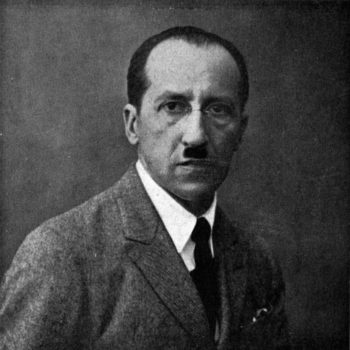At the turn of the 20th century, Dutch artist Piet Mondrian had established himself as a master of colorful, post-impressionist landscapes. But then, in the 1910s, he moved to Paris… and blew the world’s collective mind with what became his signature style: Bold, modernist paintings of colored squares, bisected with black lines.
The Gemeentemuseum, in the Dutch city of The Hague, owns the world’s largest collection of Mondrians, and from now through September 24th, it’s got them all on display. So on a recent trip to the Netherlands, Rico spoke to the museum’s director, Benno Tempel — who told him about Mondrian’s genius… and proclivity for other people’s spouses.

Benno Tempel: He influenced a lot of artists, but I think what is more important, is if you came, in the ’20s, to Paris, and you were interested in art, there was only one place that you really would love to go: the studio of Mondrian. Not to the studio of Picasso or whatever — Mondrian.
Rico Gagliano: Why? Why him instead of Picasso?
![Piet Mondrian [Public domain], <a href="https://commons.wikimedia.org/wiki/File%3AMondrian_Zelfportret_1918.jpg">via Wikimedia Commons</a>](../wp-content/uploads/2017/07/Mondrian_Zelfportret_1918.jpg)
Benno Tempel: Well, his studio was unbelievable. You stepped into another world. Through a very small door you entered his studio, and the walls were painted as are his paintings. So, his famous paintings we all know, we can dream of almost — red, yellow and blue squares and lines — in this way, he decorated the walls of his studio. So, it was unbelievable. If you entered that, you came into a world that didn’t exist anywhere else.
Rico Gagliano: Especially at that time, there was no kind of geometric modernism, I guess.
Benno Tempel: There was abstraction in art, but it was never put onto the walls of a building. So for people entering that space, it was unbelievable.
And a lot of American collectors, and American artists, and American museum curators and directors wanted to be invited or tried to get an invitation to Mondrian’s studio. But there was one deal: If you came to his studio, you had to take him out. He loved dancing. He loved a good meal. And you had to be careful; you had to look after your wife! Because if you were not looking after your wife, within a second he was dancing with her on the dance floor. This man knew how to party.
Rico Gagliano: Now, how do we see that side of him in his work? Cause if you asked most people, I think they’d say it’s the most rigid, the most simple. He uses only three colors, and black lines. That’s it. On a white background.
![Piet Mondrian's Composition II en rouge, bleu et jaune (1921). [Public domain], <a href="https://commons.wikimedia.org/wiki/File%3APiet_Mondriaan%2C_1921_-_Composition_en_rouge%2C_jaune%2C_bleu_et_noir.jpg">via Wikimedia Commons</a>](../wp-content/uploads/2017/07/Piet_Mondriaan_1921_-_Composition_en_rouge_jaune_bleu_et_noir-1024x1021.jpg)
Benno Tempel: Well, I think it comes from the same, you might say, sensitivity that you find in musicians and composers. To me, Mondrian is always the best composer of the 20th century, in art. He painted many paintings with this red, yellow, and blue. And none of them are boring. You can look at them for ages. It’s like a music piece. It’s about composition. It’s about movement. It’s about rhythm.
And I think that’s one of the reasons why he loved jazz music, and why he loved to dance. When he came to New York — he was already an elderly man then — he was dancing every night with a number of young women. One of them was Lee Krasner, who turned out to be the wife of Jackson Pollock later…
Rico Gagliano: Oh, that’s right.
Benno Tempel: …And that says something about the kind of guy he was. He really loved this rhythm, this movement. And in a sense, you can feel that in his paintings.
Rico Gagliano: Let’s talk a little bit about the technique that he used. Cause again, what seems very simple is not actually very simple.
Benno Tempel: I think that’s a very clever remark and —
Rico Gagliano: Thank you.
Benno Tempel: [Laughs.] You could say the same for Rothko. If it was only plain, flat color then it was boring. But the good thing about Rothko, about Mondrian, is that these painters paint with a brush. If you apply brush strokes from left to right, or vertical from top to bottom, it starts to reflect light. And the way you apply the brush strokes has an influence on how the light is reflected. That’s what makes these paintings alive. That’s what makes them shine, what makes them quiver, what makes them dance in a way. And I think that’s the brilliance.
But there’s another thing that’s very remarkable: If I would give you a pencil and say, “OK, draw a line,” immediately, you would see a foreground and a background. And Mondrian is one of the few — maybe the only — artist I know that draws lines, and there’s no foreground and no background. That’s magic!
Rico Gagliano: How so?
Benno Tempel: Because the logical thing of our human brain, connected to our eyes, is that we start to see depth in a drawing or a painting. As soon as there is a line, you see depth. And Mondrian somehow had the ability to bring, to a picture plane, a line and a square and still, it’s on the same level; it’s two dimensional. If you can achieve that as an artist then you do something which is almost impossible.
Rico Gagliano: Let’s also talk about the lines by the way. This blew my mind: He never used rulers, is my understanding. But you look at these paintings and every line is parallel to another line. How did that even work?
![Piet Mondrian [Public domain], <a href="https://commons.wikimedia.org/wiki/File%3AComposition_No_IV%2C_by_Piet_Mondriaan.jpg">via Wikimedia Commons</a>](../wp-content/uploads/2017/07/Composition_No_IV_by_Piet_Mondriaan-714x1024.jpg)
Benno Tempel: Well, that’s why I call him the best composer of the 20th century. A lot of things in his abstract paintings were done by intuition. Paintings were painted lying flat on a table. So he was walking around these relatively small paintings, and he was thinking, and he was applying paint to the painting. Sometimes he was taking it off again, overpainting it. And he was searching for the right harmony, the right balance or disbalance.
So it had to with sensitivity, with feeling. And I think that was what makes his paintings so brilliant. It’s very hard to copy a Mondrian because you think it’s so easy, but in the end, it has to do with feeling. It has to do with sensitivity. It’s damn difficult.
Rico Gagliano: How did he even do that, though? How did he even get a straight line without using a ruler?
Benno Tempel: Well, if you look very closely you see that it was not always completely straight. All his paintings are somehow imperfect. And I think that’s also important, because if it was perfect, then it would become a dead painting. It becomes design. In Mondrian’s paintings, you always have the feeling that it is made by a human being.
Rico Gagliano: What to you is the thing about this artist that, when you were researching him, most surprised you?
Benno Tempel: Well, you know, during the Second World War, many artists fled from Europe to America and many were homesick, were longing for the Old World. Mondrian loved everything in America and New York. He loved to be there. He loved that it was a completely new way of life. And I think that brings us the essence of his work: That every time, he was prepared to innovate himself. To change everything.
I mean, the first time he leaves for Paris, he’s almost 40. He’s one of the most renowned artists of the Netherlands. And he decides to begin again, more or less, because in Paris nobody knew him. But he does it without any hesitation. Even a hairdo, he’d cut off his beard or he’d start wearing a different hairdo or whatever. Every time, he decides to leave everything behind — to start over again.
Rico Gagliano: He was fearless.
Benno Tempel: And that says something about how beautiful and brilliant his work is.


